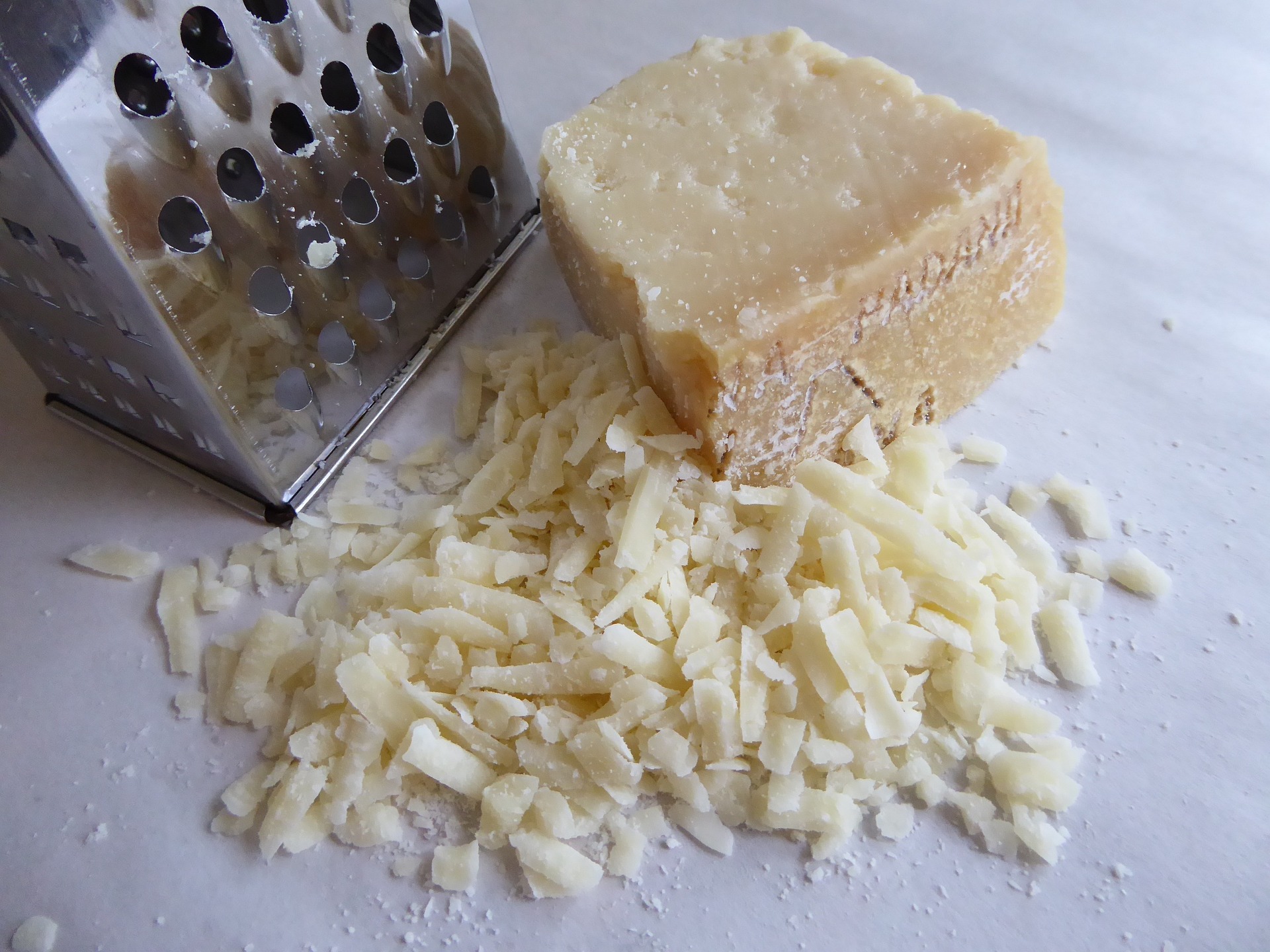Imported versus domestic Parmesan cheese – is it worth it to buy the imported? Should we ever purchase domestic?
We’ll find out.
Although imported is generally considered to be the better option, it should be noted that there are various brands of Parmesan within both domestic and imported.
This is one of the longer Difference Betweens, for those of us who really want to delve into it.
But if you’re in a rush, here’s the breakdown:
Imported Parmesan cheese:
- Is called Parmesan-Reggiano.
- Is aged for a minimum of 12 months, but usually 24 months.
- Has three ingredients: milk, salt, and rennet.
- Is consistent – always tastes the same.
- Is made from raw, partly skimmed milk.
- Comes from cows who graze in the Emilia-Romagna area of Northern Italy.
- 20 hours or less from cow to cheese.
- Curds are formed on wheels weighing 80 pounds.
Domestic Parmesan cheese:
- Can go by many names: Parmesan, Parmigiana, Parmesana, Parmabon, Parmezan, Parmezano…
- Is aged for a minimum of 10 months.
- Have any number of additional ingredients besides milk and salt, such as cellulose powder and potassium sorbate.
- Varies in taste between brands.
- Is made from pasteurized milk.
- Likely comes from cows who eat concentrated feed.
- Curds are formed on wheels weighing 24 to 40 pounds.
So. Right away, we can see how inconsistent domestic Parmesan is, and how specific and reliable imported Parmesan cheese is.
Interestingly, in 2008, the European Union declared that Parmesan-Reggiano is the only cheese that can legally be called Parmesan; the US has not followed suit.
In fact, as recently as last year Europe has been putting the pressure on us to only allow proper names for foods – not just cheese, but other products that refer to specific European regions. In addition to Parmesan, Gruyere, and Feta cheeses, other foods would lose their names as well.
US Bologna doesn’t come from Bologna, Italy. US Black Forest ham doesn’t come from the Black Forest in Germany.
And, Parmesan cheese does not come from the provinces of Parma, Italy.
Well, most doesn’t. If it does, it’s awesome and awesomely expensive – as much as $33 per pound.
Again, so far the US has resisted legally changing the names of many foods. Farmers and food producers argue the consumers knows the food they are purchasing does not come from its respective region. The word is representative of the product, not a place.
The question is, then, is there a taste difference with Parmesan cheese? Does it really need to be Parmesan-Reggiano?
Serious Eats conducted a taste test between domestic and imported Parmesan cheese. Not surprisingly, imported won, although they did give props to Trader Joe’s Parmesan cheese.
Cooks Illustrated performed a similar experiment with Parmesan cheeses. They too, preferred the authentic Parmesan-Reggaino. And, they found not one, but two domestic versions of Parmesan that were deemed acceptable.
In their taste test, Cooks Illustrated indicated the many factors that can affect the flavor of cheese, including what the cow ate.
Two further observations:
- Parmesan-Reggiano cheese wheels are 80 pounds; American Parmesan cheese wheels can be as light as 24 pounds. The smaller wheel means more cheese is exposed to the salt during brining, which can alter the flavor.
- Parmesan-Reggiano cheese is curdled with rennet, a natural enzyme from the calf intestine; American Parmesan cheese is curdled from enzymes purchased from manufacturers.
Their experiment found two domestic cheeses, aged 10 months and 20 months, to have a “pleasant nutty flavor.” Of course, Parmesan-Reggiano really came out on top.
In short, it is possible to find decent domestic Parmesan cheese, but you have to be looking for it. A Wisconsin cheese blogger makes a good case for domestic cheese – Parmesan and two others – on her blog here.
I do think it’s interesting how imported Parmesan is considered to be superior to its counterpart, and yet, in today’s consumer world, we’re encouraged to “buy local.” Should we be supporting local dairy farmers, instead of purchasing cheese from abroad?
On a personal note, I couldn’t help taking a look at the Parmesan cheese in my fridge. We have two kinds, because I like a certain kind and my husband likes the wrong kind. Admittedly, neither are freshly grated from a wedge of cheese, which is probably the best way to do it.
The husband prefers the grated kind in the plastic bottle. We have here the local Hannaford grocery store brand.
As a Forbes article I found noted, what does the 100% stand for? Because it doesn’t stand for 100% Parmesan. One hundred percent grated?
Well, yes. That it is. Touche.
Obviously this is combined with Romano cheese, although I don’t think that makes much difference.
I like Parmesan cheese that is shredded or shaved, and comes in one of those small plastic tub containers.
This is my Parmesan cheese in the apartment, what I had previously believed to be highly superior to my husband’s.
But right away we can see that mine is aged 10 months; his is aged “over 10 months.”
And, the ingredient list:
It’s harder to read with the circular angle, but it contains: Parmesan cheese (pasteurized part-skim milk, cheese cultures, salt, enzymes), powdered cellulose to prevent caking, natamycin to protect flavor.
Actually, both potassium sorbate and natamycin are there not for flavor, but to prevent mold from growing.
So, both cheeses have the anti-fungal factor and have been aged around 10 months. Both contain cheese cultures and powdered cellulose, neither of which are in Parmesan-Reggiano.
Powdered cellulose, by the way, consists of minuscule pieces of wood pulp and plant fibers. Yep.
There may be decent domestic Parmesan cheeses but I’m not sure they’re in my apartment.
